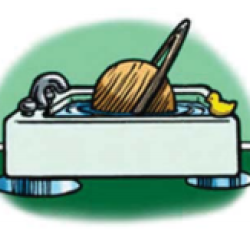Source Institutions
Source Institutions
Add to list Go to activity
Activity link broken? See if it's at the internet archive

In this demonstration, learners compare the relative sizes and masses of scale models of the planets as represented by fruits and other foods. Learners dunk the "planets" in water to highlight the fact that even a large, massive planet — such as Saturn — can have low density. They discuss how a planet's density is related to whether it is mainly made up of rock or gas. This activity is part of a sequence of activities focused on Jupiter's immense size.
- 10 to 30 minutes
- 30 to 45 minutes
- $10 - $20 per group of students
- Ages 8 - 14
- Activity, Demonstration, Lesson/Lesson Plan, Model
- English
Quick Guide
Materials List (per group of students)
- (5 1/2"-wide) large mango or potato
- (4 1/2"-wide) large unpeeled orange, coconut, or cantaloupe
- (2"-wide) plum
- (2"-wide) kiwi or lime (not a lemon)
- (1/2"-wide) small grape
- (1/2"-wide) large blueberry
- (1/4"-wide) pea or navy bean
- (1/5"-long) uncooked orzo pasta
- 1 (18" wide x 8" deep or larger) bowl, tub, or small wading pool
- A sink or other access to water
- 1 golf ball or ball bearing (optional)
- 1 ping-pong ball or a marble that is similar in size to the ball bearing (optional)
- "Dunking the Planets" pages
- Pens or pencils
Subjects
-
Earth and Space Science
- Astronomy
-
Earth Structure
- Rocks and Minerals
-
Solar System
- The Planets
-
Mathematics
-
Measurement
- Units of Measurement
- Representation
-
Measurement
-
Engineering and Technology
-
Engineering
- Metallurgy and Materials Engineering
-
Engineering
-
Physical Sciences
-
Motion and Forces
- Gravity
-
States of Matter
- Solids
- Gases
-
Structure and Properties of Matter
- Atomic Structure
- Mass and Weight
- Volume and Density
-
Motion and Forces
-
The Nature of Science
-
The Scientific Process
- Conducting Investigations
- Gathering Data
- Formulating Explanations
- Communicating Results
-
The Scientific Process
Informal Categories
- Food and Cooking
- Outdoor Activity
Audience
To use this activity, learners need to:
- see
- read
- touch
Learning styles supported:
- Involves hands-on or lab activities
Other
Components that are part of this resource:
- Big Kid on the Block (activity series)
- "My Trip to Jupiter" Journal
- Background Information: Secrets of the Solar System Family
- Background Information: The Other Distant Giants Are Kindred Planets with Individual Quirks
- Background Information: Inner, Rocky Neighbors Are Siblings to Earth
- Background Information: Countless Small Objects Are Part of Our Solar System's Extended Family
- Shopping List
- Dunking the Planets: Selecting Appropriate Foods
Includes alignment to state and/or national standards:
This resource is part of:
Access Rights:
- Free access
By:
- Department of Education and Public Outreach, Lunar and Planetary Institute; Juno Education and Public Outreach, NASA
Rights:
Funding Source:
- NASA
